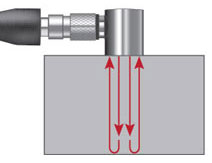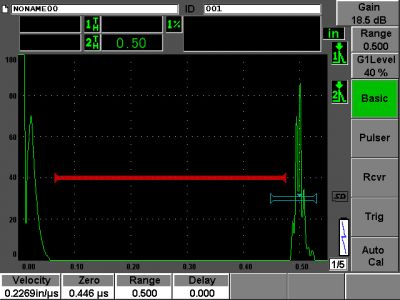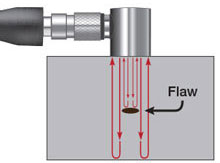5.1 垂直声束检测(板材、棒材、锻件、铸件等)
Straight beam testing is generally employed to find cracks or delaminations parallel to the surface of a test piece, as well as voids and porosity. It may use contact, delay line, dual element, or immersion transducers, all of which launch longitudinal waves on a straight path into the test piece. Common applications include testing plates, bars, forgings, and castings, as well as bolts and hanger pins and similar parts that can crack parallel to an accessible surface. Straight beam testing is also commonly employed in testing fiberglass and composites, as discussed in section 7.6.
Like all other ultrasonic flaw detection techniques, straight beam testing utilizes the basic principle that sound energy traveling through a medium will continue to propagate until it either disperses or reflects off a boundary with another material, such as the air surrounding a far wall or the gap created by a crack or similar discontinuity. In this type of test, the operator couples the transducer to the test piece and identifies the echo returning from the far wall, as well as any fixed reflections originating from geometrical structures such as grooves or flanges. After noting the characteristic pattern of echoes derived from a good part, the operator then looks for any additional echoes that appear ahead of that backwall echo in a test piece, discounting grain scatter noise if present. An acoustically significant echo that precedes the backwall echo implies the presence of a laminar crack or void. Through further analysis, the depth, size, and shape of the structure producing the reflection can be determined.
No Flaw Present
Sound travels through material and reflects off backwall.
Flaw Present
- Some sound travels through entire material and reflects off the backwall, while some reflects off the intermediary flaw
- Echo amplitude correlates to flaw size
In the case of flat plates and smooth bars, this procedure is usually straightforward.
Straight beam testing can also be used to test braze joints and other bondlines that are oriented parallel to the surface. In these cases, even a good joint typically returns an echo since the braze metal or bonding material differs from the material being joined. However comparative testing will normally show that a lack of bonding returns an even larger echo, so the bondline echo amplitude is used as an indicator of the bond condition.



